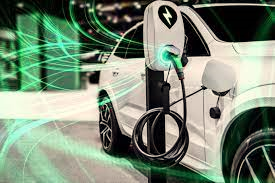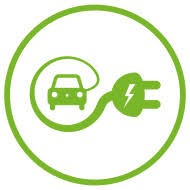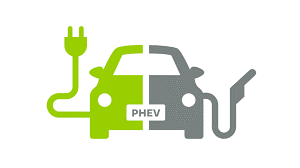Revolutionizing Transportation the Emergence of the E-Mobility Market
17-Sep-2024

An Overview of E-Mobility Market
E-mobility or electric mobility refers to the shift from internal combustion engine (ICE) vehicles to battery-powered electric vehicles (EVs). It represents the concept of integrating electric powertrain technology, in-vehicle information and communication technologies, and connected infrastructures to enable the vehicle’s electric power. Automotive e-mobility includes a wide range of EVs such as electric cars, e-bikes, pedelecs, electric motorbikes, e-buses and e-trucks, all of which are entirely or partially powered by electricity.
What are the types of E-Mobility Vehicles?

Electric Vehicles (EVs)/Battery Electric Vehicles (BEVs): No gasoline engine is used in these fully electric vehicles; rechargeable batteries provide the power. Electric vehicles are zero-emission vehicles and can be charged at a power station, home, or charging station.

Plug-in Hybrid Electric Vehicles (PHEVs): These vehicles comprise of an engine and electric motor for driving the car. It uses around 30% to 60% less petroleum than conventional vehicles. These vehicles are able to charge their batteries through regenerative braking and charging equipment.

Hybrid Electric Vehicles (HEVs): Modern hybrid electric vehicles (HEVs) combine an internal combustion engine with one or more electric motors that use electricity from batteries to operate. The vehicle is driven and charged by the petrol engine when the battery is dead. Completely electric or plug-in hybrid vehicles are more efficient than these vehicles.

Fuel Cell Electric Vehicles (FCEVs): Hydrogen-powered FCEVs are zero-emission vehicles and are more efficient than conventional vehicles. It runs on fuel cell technology that generates the electricity required to run the vehicle. Electric energy is produced from the fuel’s chemical energy.
Why E-Mobility is Important?
Electric mobility improves quality of life by removing harmful pollutants from the environment. EVs help combat climate change as these vehicles do not have combustion engines and reduce greenhouse gases emissions. Therefore, global efforts to increase the use of EVs are crucial to achieving sustainable mobility. Policies such as electrification of urban public transportation, changes in tax laws, development of regulatory frameworks, and integration of EVs into urban infrastructure planning are all part of the effort.
Electric mobility also helps in maintaining a balance between energy demand, energy storage and environmental sustainability. It is one of the most innovative clusters in the automotive industry, with zero or extremely low tailpipe emissions of local air pollutants and produces significantly less noise. This makes it one of the most attractive forms of transportation for investment and boosts economic and industrial competitiveness across nations.
Important Components of E-Mobility
.png )
Batteries are an important element in zero-emission vehicles. An EV’s battery is an energy accumulator that stores electricity for delivery to an engine using either alternating or continuous current. These vehicles are sustainable because of the battery, which releases them from reliance on fossil fuels.
.png)
Charging stations is one of the crucial infrastructures for e-mobility. The availability of charging stations for EVs influences consumer purchase decisions. The surge in the demand for EVs facilitates EV charging providers to focus on providing reliable and innovative charging solutions. Modern EVs require compact EV charging solutions and must ensure fast, on-demand charging as well as reliable communication.
.png)
Charging cables is another significant part of charging an electric vehicle. The vehicle charger can be connected to a charging station in public or at home via charging cables. There are different types of charging cables, known as charging modes, that determine how long it takes to charge a vehicle.
A Look at the Different Types of E-Mobility Products Sales Trends
Based on the product type, the e-mobility market is divided into electric bicycle, electric skateboard, electric car, electric motorcycle, electric wheelchair, and electric scooter. The electric car segment has the highest growth rate globally. An electric car is a self-driving vehicle powered by an electric motor. The electric car operates on electricity and requires a constant supply of energy from batteries to operate instead of any internal combustion engine of petrol or diesel. The various government policies that support purchasing of EVs to reduce carbon emission, rising fuel prices, reduced sound from engine and reduced cost of EVs leads to high penetration of electric cars, which in turn drives the demand for e-mobility.

E-Mobility Market Share Analysis
There are numerous companies that are engaged in the manufacturing of e-mobility products. Leading players are fortifying their positions through a range of strategies, including the introduction of new products, partnerships, collaboration, acquisitions, and company growth.
Next Move Strategy Consulting recognizes at least 10 biggest players in the market including Tesla, Nissan Motor Corporation, BMW Group, General Motors Company, Volkswagen AG, and others.

Market Share Analysis by Region
The Asia Pacific region holds the largest market share of the e-mobility market, which is accounted for 49.20%; this can be attributed to the presence of China, which is the leading producer and records the highest number of sales about 3,519,054 units in the global EV market. In addition, the governments in various countries in this region are providing subsidies and incentives to the buyers of EVs, regulating excessive polluting vehicles, and supporting the installation of EV charging stations across cities, which in turn drives the e-mobility industry.
Europe comes second with a market share of 28.60% due to the surge in the number of unit sales of electric cars and vans in Europe. According to the International Council on Clean Transportation, the sales of EVs in Europe were 2.3 million in 2021, a 66% increase from 2020. North America accounts for a share of 16.30% of the global e-mobility market owing to factors such as growing concern for a pollution-free environment and rising stringent emissions rules and regulations for vehicles, which in turn drives the growth of the e-mobility market in this region.
Opportunities for a Sustainable Future of the E-Mobility Market
The growing advancements of solar panel technology that have promising futures due to the surge in EVs is expected to increase global demand for electricity. Manufacturers of EVs around the world are working towards a sustainable increase in electric production to reduce the carbon emissions of fossil fuel electricity generation. The solar-powered charging devices are fast and inexpensive that increases the accessibility of charging stations and adoption of EVs, which contributes to creating ample growth opportunities for the e-mobility market in the near future.
About the Author
 Priyanka Paul is a highly skilled and experienced researcher, with a passion for conducting thorough and accurate research. As a researcher, she is responsible for gathering, analyzing, and interpreting data, and helping her clients to deal with complex business challenges. With a Master's degree in Commerce, she has a strong foundation in data analysis and synthesizing relevant information to support a wide range of projects. She is an avid reader and has a love for traveling and exploring new cultures. The author can be reached at info@nextmsc.com
Priyanka Paul is a highly skilled and experienced researcher, with a passion for conducting thorough and accurate research. As a researcher, she is responsible for gathering, analyzing, and interpreting data, and helping her clients to deal with complex business challenges. With a Master's degree in Commerce, she has a strong foundation in data analysis and synthesizing relevant information to support a wide range of projects. She is an avid reader and has a love for traveling and exploring new cultures. The author can be reached at info@nextmsc.com
Add Comment
Related Blogs
Major Industry Leaders and Their Impact on the Automotive Robotics Market
Automotive robotics market expected to experience rapid grow...
Tech Titans Transforming AI Robots: IBM, Intel, and Microsoft's Influence
According to Next Move Strategy Consulting, the AI Robots Ma...
UGVS and the Power Players: Genetal Dynamics, Qinetiq, and Boston Dynamics
According to Next Move Strategy Consulting, the UGV Mar...




.jpg )







